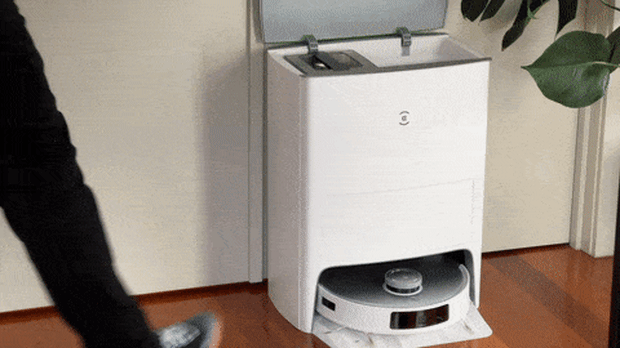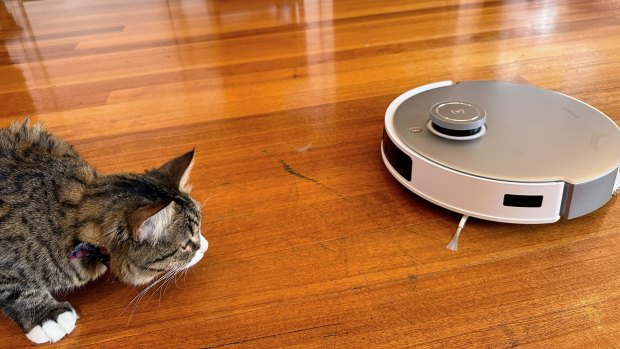
More autonomy, but more maintenance
In addition to bagging their own dust, many new models also come with the ability to mop and vacuum at the same time. But sometimes, more complicated designs mean more for you to do, and the time, energy and money calculus of a robot vac versus a manual one becomes more difficult. The T20 Omni offers a striking example here.
This is a big robot that lives in an enormous base, and it’s designed to vac and mop your whole house, with hot water, while also cleaning and drying its own mop pads and ejecting its own dust. And while part of its operation could definitely be called autonomous, it still needs human help.
Inside its big house are two water tanks. One you need to fill with clean water, which it runs through a heating pipe and uses to fill a sink under the robot. It soaks its mop pads there, then heads off to clean. It can detect when extra cleaning is needed, or when it hits carpet and so needs to raise its wet pads, and it will plan to come back several times to get more water or recharge. The dirty water from the pads gets sucked into the second water tank, which you need to empty. I can imagine a future version of this with a washing-machine-style inlet and pipe, so it could fill and drain its own tanks, which would make its day-to-day totally autonomous.

Clean water in, dirty water out (this clip is edited and sped up). Credit: Tim Biggs
But you’d still have regular maintenance and so-called consumable parts to contend with. The manual for the T20 Omni recommends a weekly cleaning regimen of all the robot’s parts, as well as a deep scrub of elements like the brushes, sink and tanks every few weeks to a month. It’s not a huge job, but it will have you contemplating whether you could just get by vacuuming the house once a week instead. Also onerous is the ongoing cost of having to buy new pads, dust bags, brushes and filters every six months or so.
Different robots have different setups. The Combo j+ for example has its mop pads on a hinge and carries its own water reservoir, which is good because it means it can handle deeper carpets than the Deebot (which can only lift its wet pads so high), but it also means more manual filling and rinsing. Regardless, you’re still looking at regular maintenance and replacement parts. Don’t think you can get away with reusing bags and filters like I once did, and end up with a case of what I’m pretty sure were mould mites.
A fur baby’s friend, or foe
In my experience, pets all have one of two reactions to robot vacuum cleaners; they either fear them and retreat, or they mess with them mercilessly. Our cat, Risky, falls squarely into the latter camp. He bats and licks the rotating brushes, and I’m not sure whether that’s worse for our floors or his health.
He pounces from behind plants for a quick swipe and darts away. He lays in the robot’s path and refuses to move despite its prodding. It’s simply impossible to stop him, although he doesn’t seem to like walking through the wet parts of the floor during mopping, which is good.

Moments before a big boop.Credit: Tim Biggs
Most vacs are designed to detect objects ahead and avoid damaging them, though this is obviously harder to do when the object is moving maliciously. Of all the vacs I’ve tested, I’ve never had one hurt a pet, but I have had a few be cornered and eventually give up or run out of battery without being able to return home.
Loading
Ordinarily I just leave the robot to do its job, and in most cases it will work around the animals. The T20 Omni is an interesting case though because it provides a very detailed map that you can watch on your phone in real time, or see a complete record of where the robot went after the fact. So I can see clearly that, amongst the grid of straight lines and occasional rotations where it’s detected a patch that needs extra cleaning, the robot had to make way for a cat-shaped lump two or three times per clean.
On the other hand, running the vac every day is definitely worth it to take care of the tail hair tumbleweeds that would otherwise congregate and blow around the place.
The internet is full of videos where robot vacuums have been turned into makeshift pet companions by sticky taping some toys to it or putting some treats on top, and if you think your cat might be content to ride on the robot rather than fight it, you could give that a try.
But I think I’ll stick to discouraging contact as much as possible.
Get news and reviews on technology, gadgets and gaming in our Technology newsletter every Friday. Sign up here.



























